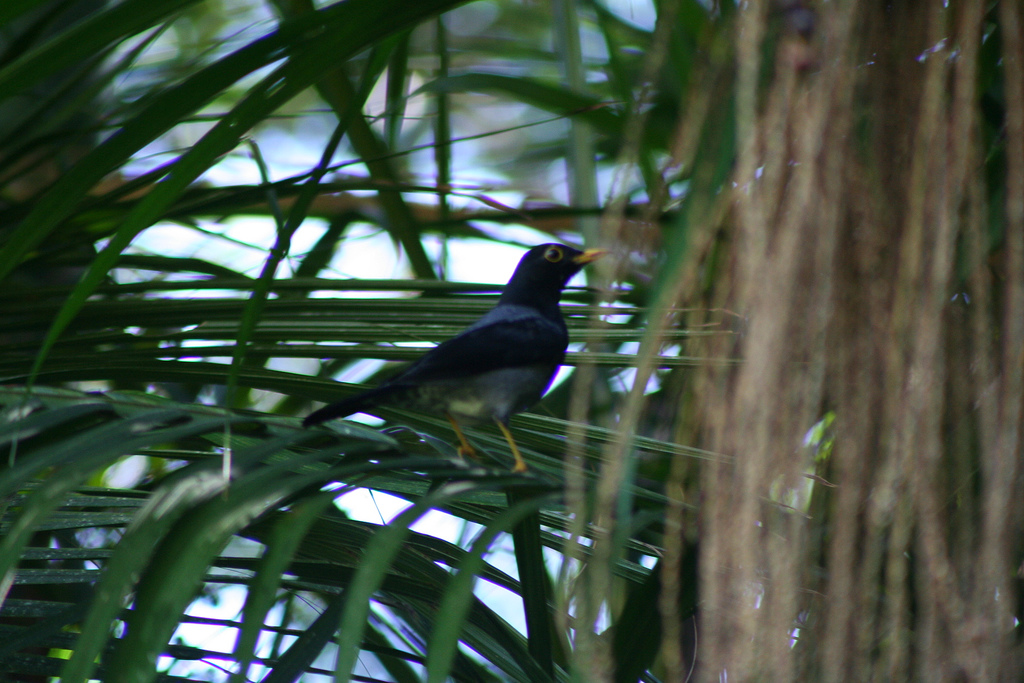- Yellow-legged Thrush
Taxobox
name = Yellow-legged Thrush

image_width = 240px
status = LC
status_system = iucn3.1
regnum =Animal ia
phylum =Chordata
classis =Aves
ordo =Passeriformes
familia =Turdidae
genus = "Platycichla "
species = "P. flavipes"
binomial = "Platycichla flavipes"
binomial_authority = (Vieillot,1818 )The Yellow-legged Thrush ("Platycichla flavipes") is a
songbird of northern and easternSouth America .Description
This thrush is 8½ in (22-23 cm) long and weighs 2-2½ oz (55-70 g). Both sexes have a yellow legs and eyering. The male has a yellow bill and its
plumage is black black, except for the slate grey back and lower underparts. However, the male of one of the fivesubspecies , "Platycichla flavipes xanthoscelus" ofTobago , is all black, thereby resembling the maleEurope anBlackbird . Females have a dull bill, warm brown upperparts and paler underparts. The juvenile male is brownish with black wings and tail, while the juvenile female resemble theadult female, but is duller, flecked with orange above and spotted and barred with dark brown below.The song of the male is musical phrases, "sreep, sreee, sree, sreee", again somewhat resembling that of the Blackbird, but sometimes including some imitation of other birds songs. The typical call is a sharp "srip" and a peculiar "seeet" given in alarm.
Distribution and ecology
It has a highly
disjunct distribution ; breeding in northernColombia ,Venezuela , westernGuyana , far northernBrazil ,Trinidad andTobago , with a separate population in easternBrazil , easternParaguay and far northeasternArgentina . Last mentioned population is partially migratory, being resident in the northern part, while southernmost breeders spend the Austral winter further north. Some populations in northernSouth America also take part in local movements, but these are not well understood.The habitat of this small thrush is
rainforest , secondary woodland and overgrownplantations . It is mainly aspecies of highlands up to 2000 m. (6500 ft), but locally it occurs down to nearsea level [Hilty (2003), Strewe & Navarro (2004)] . The Yellow-legged Thrush mainly feeds in trees and bushes (infrequently on the ground) onfruit s andberries . It is a shy species, and the female in particular is difficult to see, since she does not sing.The nest is a lined shallow cup of twigs on a bank or amongst rocks. Two or three reddish-blotched green or blue eggs are laid.
It is fairly common in most of its range, and therefore listed as
Least Concern byBirdLife International .Footnotes
References
*|year=2004|id=51581|title=Platycichla flavipes|downloaded=12 May 2006 Database entry includes justification for why this species is of least concern
* (2000): "Thrushes". Christopher Helm, London. ISBN 0-7136-3940-77
* (1991): "A guide to the birds of Trinidad and Tobago" (2nd edition). Comstock Publishing, Ithaca, N.Y.. ISBN 0-8014-9792-2
* (2003): "Birds of Venezuela". Christopher Helm, London. ISBN 0-7136-6418-5
* (2004): New and noteworthy records of birds from the Sierra Nevada de Santa Marta region, north-eastern Colombia. "Bull. B.O.C." 124(1): 38-51. [http://www.alpec.org/Articulo%20BBOC/Strewe%20&%20Navarro%202004%20BBOC%20124%20(1).pdf PDF fulltext]
* (1994): "They Have Yellow Legs: An Odyssey into the World of Yellow-legged Thrushes"Verify source|date=September 2007
Wikimedia Foundation. 2010.
